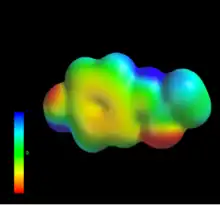Polar surface area
The polar surface area (PSA) or topological polar surface area (TPSA) of a molecule is defined as the surface sum over all polar atoms or molecules, primarily oxygen and nitrogen, also including their attached hydrogen atoms.

Electrical potential surface of paracetamol showing polar areas in red and blue
PSA is a commonly used medicinal chemistry metric for the optimization of a drug's ability to permeate cells. Molecules with a polar surface area of greater than 140 angstroms squared (Å2) tend to be poor at permeating cell membranes.[1] For molecules to penetrate the blood–brain barrier (and thus act on receptors in the central nervous system), a PSA less than 90 Å2 is usually needed.[2]
See also
References
- Pajouhesh H, Lenz GR (Oct 2005). "Medicinal Chemical Properties of Successful Central Nervous System Drugs". NeuroRx. 2 (4): 541–553. doi:10.1602/neurorx.2.4.541. PMC 1201314. PMID 16489364.
- Hitchcock SA, Pennington LD (May 2006). "Structure - Brain Exposure Relationships". J. Med. Chem. 49 (26): 7559–7583. doi:10.1021/jm060642i. PMID 17181137.
Literature
- Pajouhesh, Hassan; Lenz, George R (2005). "Medicinal chemical properties of successful central nervous system drugs". NeuroRx. 2 (4): 541–553. doi:10.1602/neurorx.2.4.541. PMC 1201314. PMID 16489364.
- Clark, David E (1999). "Rapid calculation of polar molecular surface area and its application to the prediction of transport phenomena. 1. Prediction of intestinal absorption". Journal of Pharmaceutical Sciences. 88 (8): 807–14. doi:10.1021/js9804011. PMID 10430547.
- Palm, Katrin; Stenberg, Patric; Luthman, Kristina; Artursson1, Per (1997). "Polar molecular surface properties predict the intestinal absorption of drugs in humans". Pharmaceutical Research. 14 (5): 568–71. doi:10.1023/A:1012188625088. PMID 9165525. S2CID 7178582.
- Ertl, Peter; Rohde, Bernhard; Selzer, Paul (2000). "Fast Calculation of Molecular Polar Surface Area as a Sum of Fragment-Based Contributions and Its Application to the Prediction of Drug Transport Properties". Journal of Medicinal Chemistry. 43 (20): 3714–3717. doi:10.1021/jm000942e. PMID 11020286.
- Ertl, P. Polar Surface Area, in Molecular Drug Properties, R. Mannhold (ed), Wiley-VCH, pp. 111–126, 2007
- Shityakov, Sergey; Neuhaus, Winfried; Dandekar, Thomas; Förster, Carola (2013). "Analysing molecular polar surface descriptors to predict blood-brain barrier permeation". International Journal of Computational Biology and Drug Design. 6 (1–2): 146–56. doi:10.1504/IJCBDD.2013.052195. PMID 23428480.
This article is issued from Wikipedia. The text is licensed under Creative Commons - Attribution - Sharealike. Additional terms may apply for the media files.